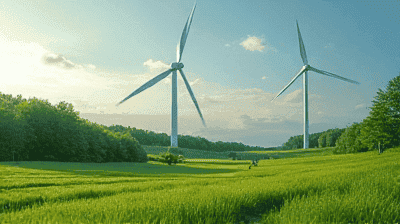
As the impacts of climate change become increasingly apparent, the need for immediate and effective action has never been more urgent. The European Union (EU) has responded to this challenge with the European Green Deal, an ambitious plan to transform its economy and society to achieve climate neutrality by 2050.
The European Green Deal, unveiled in December 2019, is a comprehensive policy framework aimed at making the EU’s economy sustainable. It seeks to address various environmental challenges, including climate change, biodiversity loss, pollution, and the transition to clean energy. The main objective of the Green Deal is to achieve net-zero greenhouse gas emissions by 2050, transitioning the EU into a resource-efficient economy that respects the planet’s ecological boundaries.
The European Green Deal encompasses a wide range of objectives and initiatives, including:
Reducing Greenhouse Gas Emissions: Aiming for a net reduction of at least 55 percent of greenhouse gas emissions by 2030 compared to 1990 levels.
Promoting Sustainable Industry: Supporting industries in the transition to clean technologies, circular economy practices, and sustainable supply chains.
Enhancing Energy Efficiency and Renewable Energy: Increasing energy efficiency in buildings and promoting renewable energy sources to reduce dependence on fossil fuels.
Investing in Green Infrastructure: Developing sustainable transport systems, enhancing biodiversity, and protecting natural ecosystems.
Mobilizing Financing for the Transition: Leveraging public and private investments to fund the necessary changes, including the Just Transition Mechanism to support regions and sectors most affected by the transition.
Promoting Research and Innovation: Investing in new technologies and encouraging research and development to foster innovation in sustainable practices.

The scientific consensus on climate change underscores the urgent need for action. The Intergovernmental Panel on Climate Change (IPCC) warns that without immediate and substantial reductions in greenhouse gas emissions, global warming is likely to exceed 1.5 degrees Celsius, with catastrophic consequences for ecosystems and human societies. In response, the EU has recognized its responsibility as a regional and global leader in climate action.
The European Green Deal builds on prior EU commitments, including the Paris Agreement, which seeks to limit global warming to well below 2 degrees Celsius. The EU’s previous climate and energy frameworks, such as the 2020 Climate and Energy Package, laid the groundwork for more ambitious targets. The Green Deal represents a significant escalation in these efforts, reflecting the increasing urgency of the climate crisis.
The public is increasingly aware of climate change, with many citizens supporting measures to combat it. The European Green Deal has garnered substantial political backing from EU leaders, although the successful implementation of its objectives will require collaboration across member states, industries, and civil society.
Fit for 55 Package: Accompanying the Green Deal, the EU has introduced the "Fit for 55" legislative package. This proposal aims to align EU policies with the 2030 climate target, covering areas such as emissions trading, renewable energy, and energy efficiency.
ETS Reforms: The EU Emissions Trading System (ETS) will be reformed to ensure that it remains effective in reducing emissions across multiple sectors. The cap-and-trade system incentivizes companies to lower their emissions by allowing them to buy and sell carbon allowances.
Biodiversity Strategy for 2030: The Green Deal includes a commitment to protect and restore biodiversity, setting targets to protect at least 30 percent of land and sea in Europe. This strategy aims to halt the loss of species and habitats while enhancing the resilience of ecosystems.
Pollinator Protection: The Green Deal recognizes the importance of pollinators for biodiversity and food production, introducing measures to protect them and their habitats.
Farm to Fork Strategy: The Green Deal emphasizes sustainable agricultural practices, aiming to reduce the environmental impact of the EU food system. This includes promoting organic farming, reducing pesticide use, and improving animal welfare standards.
Addressing Food Waste: A commitment to reduce food waste at all stages of the supply chain will enhance sustainability and contribute to food security.
Renewable Energy Target: The Green Deal sets an ambitious target to increase the share of renewable energy in the EU to at least 40 percent by 2030.
Decarbonizing Heating and Cooling: The initiative promotes energy efficiency improvements in buildings, encouraging investments in renewable heating and cooling systems.
Transport Policy: The Green Deal aims to promote greener transport options, including expanding public transport, investing in alternative fuels, and enhancing infrastructure for electric vehicles.
Reducing Emissions from Transport: The EU plans to propose measures that address emissions from various transport sectors, including road transport, shipping, and aviation.
Just Transition Mechanism: To ensure a fair transition, the EU has established a Just Transition Mechanism to support regions and workers affected by the transition from fossil fuel dependency. This mechanism aims to provide financial assistance and opportunities for retraining and reskilling.
Green Financing: The EU plans to mobilize investments by leveraging public and private financing, including the EU budget, national budgets, and the private sector. The European Investment Bank plays a key role in financing climate-friendly projects.

Each member state will need to develop its own national plans and strategies to align with the goals of the European Green Deal. This involves adapting to local contexts while meeting EU-wide targets. Countries with varying economic structures and reliance on fossil fuels may face differing challenges and opportunities in the transition.
The Green Deal presents significant economic opportunities for the EU, including the creation of green jobs and innovations in technology. However, a transition away from fossil fuels may also lead to job losses in traditional industries, necessitating targeted support for affected workers and communities.
Public engagement is critical for the success of the Green Deal. Building awareness and support among citizens, businesses, and stakeholders will be key to achieving the ambitious targets set forth. Addressing concerns about potential socio-economic impacts will also be essential for garnering public support.
The diverse political landscape within the EU presents challenges to achieving consensus on climate policies. Member states have different priorities, economic structures, and capacities, leading to potential disagreements on the pace and direction of the transition.
Several EU member states remain heavily reliant on fossil fuels for their energy and economic needs. Transitioning away from these sources requires significant investment, innovation, and time. Countries with a strong coal industry, for example, may face resistance to rapid changes.
Securing adequate funding for the ambitious initiatives outlined in the Green Deal poses a challenge. While the EU aims to mobilize public and private investments, ensuring consistent and effective financing mechanisms will be crucial for the sustainable transition.
The transition to a climate-neutral economy necessitates advancements in technology and infrastructure. This includes the development of renewable energy sources, energy-efficient technologies, and systems for carbon capture and storage. Overcoming technical barriers and scaling up innovations will be key to achieving the Green Deal’s objectives.

The European Green Deal serves as a benchmark for global climate action, showcasing the potential for ambitious policies and strategies to drive meaningful change. As one of the largest economies in the world, the EU's commitment to climate neutrality sets a powerful example for other regions.
The Green Deal strengthens the EU's role as a global leader in climate action, reinforcing its commitment to international agreements such as the Paris Agreement. The EU can leverage its influence to foster international cooperation and encourage other nations to adopt ambitious climate goals.
The EU has a responsibility to support developing nations in their climate efforts. By sharing technology, expertise, and financial resources, the EU can help create a more equitable global response to the climate crisis.
The European Green Deal represents a monumental step toward a sustainable, climate-neutral future for the EU. With its comprehensive strategy and ambitious goals, the Green Deal aims to transform economic systems, enhance biodiversity, and promote social equity. As the EU seeks to become the first climate-neutral continent, the success of this initiative will depend on collaboration, innovation, and commitment at all levels—from the EU institutions to national governments and local communities.
While challenges lie ahead, the European Green Deal offers a roadmap for the EU to lead the way in global climate action. It is an opportunity to demonstrate that a sustainable future is not only necessary but also possible, paving the way for a healthier planet and a more resilient society.